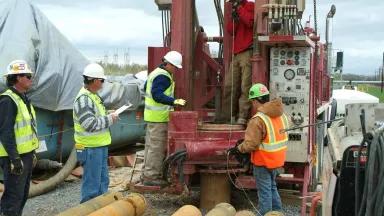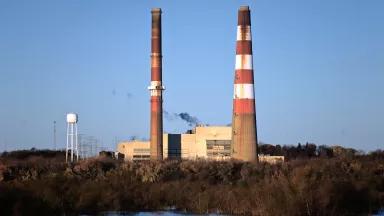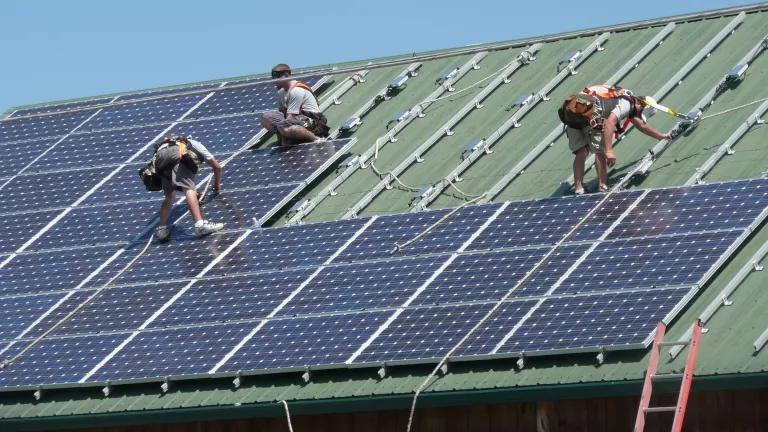Communities First: Equity and Justice in the Just Transition
Without actions promoting equity and justice throughout the process, the renewable energy transition will fail to earn the trust of frontline communities.

Local community teams from across the country collaborate at a working session of the Solar Energy Innovation Network. The program brings together underserved communities to explore new approaches to the equitable adoption of solar energy.
Harrison Dreves, NREL 73574
As the transition to renewable energy accelerates, a focus on the transition's equity and environmental justice aspects must follow suit. Without actions promoting equity and justice throughout the process, the renewable energy transition will fail to earn the trust of frontline communities.
Fossil fuel dependency has brought more than a century of environmental devastation to frontline communities across the country. From polluted waterways to particulate matter in the air, access to clean water and air and the well-being of local ecosystems are constantly under threat. Pollutants from burning fossil fuels—like nitrogen oxides, carbon monoxide, and mercury—can end up in our food, water, and air and cause health complications like respiratory and cardiovascular conditions. Meanwhile, dependence on fossil fuels leaves consumers at the mercy of geopolitics and global price swings and entrenches local economic dependencies on resource revenues that are likely to decline significantly in the coming decades. Leaving that dependence behind provides an opportunity to rethink our extractive economy, our generation of waste, and the impacts those activities have on families, communities, and our broader society. Failure to seize that opportunity, however, means repeating the mistakes of the past.
Equity considerations in renewable energy transition
Take some of the processes used to produce lithium. Lithium is a mined material that is critical in current formulations for high-capacity batteries, which are used in things like electric vehicles. Our need for large quantities of lithium means global pressure exists to find and develop mines capable of meeting present and future demand. With these pressures comes an immediate test: Can this development take place in a way that is equitable and just, what exactly does that mean, and how does it play out in the project development process?
Mining companies can extract lithium through the evaporation of salt-flat brines and by extracting and crushing lithium-rich ores found in open-pit mines. Open-pit mines are one of the most controversial and environmentally risky types of sourcing. In the United States, the Thacker Pass mine in Humboldt County, Nevada, is a poster child for the kinds of controversy that can quickly emerge when companies propose industrial development near vulnerable populations and critical environmental resources. The managing mining company, Lithium Americas, has successfully cleared all needed permits for the proposed project and attained a Record of Decision in January 2021 from the Bureau of Land Management. However, on February 7, a judge ruled that the permit allowing the project to commence should be reconsidered and that a waste rock study must be implemented during initial construction. Although Lithium Americas representatives believe their permitting process “was conducted thoroughly and responsibly,” community members whose lands will be impacted claim the opposite. A rushed and inexhaustive review process for a proposed project can lead to communities feeling exploited and disrespected because extractive activities like open-pit lithium mining will impact local communities for decades. How can the transition from fossil fuels truly be equitable when a community feels unheard, disregarded, and betrayed?
The roots of the Just Transition framework
Calls for a “just transition” are a direct reaction to persistent inequities for people of lower socioeconomic backgrounds, BIPOC (Black, Indigenous, People of Color) communities, and other marginalized groups who have historically been most impacted by past extraction and, once again, find themselves on the newly drawn frontlines of future extractive industry. Cases like the Thacker Pass lithium mine project remind us that inequity and injustice can remain in the transition away from fossil fuel dependency. But they also provide an opportunity to solve identified missteps in equity and provide marginalized communities with more options for employment, a chance to revitalize community systems for the better, and mitigate environmental harms.
A just transition aims to account for the inequities in the extractive industry by, for example, developing cleanup procedures for closed facilities so they don’t continue to interfere with the lives of those in the surrounding area. A just transition focuses on identifying and rectifying the adverse health effects of fossil energy or harmful environmental impacts and the economic well-being of the communities impacted.
What does this look like in practice? The following considerations provide several examples of considerations that are essential when undertaking just transition discussions:
- Definition and identification of marginalized groups to target equity work
- A holistic review of the social, ancestral, and environmental history of the region
- Communication and involvement of representative community groups
- Candid review of existing inequities (e.g., economic, social) using regional data
- Systems of accountability for equity work moving forward
The Climate Justice Alliance (CJA) is a prominent organization that has helped define the principles for a just transition. The CJA asserts that bringing community members and decision-makers to the same table to hold conversations about their shared future is effective in imagining the reality that follows—the end of fossil fuel reliance and whatever comes next.

Tribal Energy Project Development and Financing Workshop participants collaborate on an exercise to help them identify available renewable resources, find suitable sites, and determine the potential of tribal renewable energy projects.
John De La Rosa, NREL 28048
The CJA’s Just Transition framework is composed of actions with a unified purpose to provide resources and assistance to those who have been negatively impacted the most by, for example, the extractive industry, through health impacts, costs from natural disaster recovery, and pollution. Just transition work allows communities to determine areas for improvement in terms of equity, effectively communicate with affected residents, and close gaps in energy efficiency and climate resiliency, for generations to follow. If done effectively, a community has the opportunity to build foundations that will allow residents to work together and hold conversations that are necessary to bringing the path of the community forward. If done effectively with people of various backgrounds, grassroots groups, and frontline community members at the table, then the trust that constituents have for the government’s ability to prepare its people during a period of transition toward something better will increase. Lastly, it will uplift those most negatively impacted by extractive activities and improve the lives of those in frontline communities who have been facing these impacts for generations and feeling the repercussions.
Peoria, Illinois, community practices just transition work
With the passing of the Inflation Reduction Act in 2022 and an increased interest in critical minerals, we can forecast more localized discussions about transitioning away from fossil fuel dependency and moving toward cleaner energy in the United States. Communities like Peoria, Illinois, have already begun doing the work following just transition principles that organizations like CJA have put forth. The closure of the E.D. Edwards coal-fired power plant through a 2019 settlement order—accomplished with the help of NRDC, Sierra Club, and the Chicago Respiratory Health Association, among others—led to grants for clean energy–forward projects. The plant had been a well-known emitter of soot, a deadly air pollutant, negatively impacting residents in the area for decades, with many suffering health complications that limited the promised economic opportunities the plant was supposed to bestow on nearby residents. Built during the 1960s, the retired plant had been violating the Clean Air Act for several years before the suit.

Downtown Peoria, Illinois
An important element in the outcome of the Peoria situation was the economic assistance that the settlement provided residents. The dollars from the plant owners allowed for funds to cover projects following just transition principles spearheaded by frontline community leaders. Without financial capital, unfortunately, just transition projects can’t take place. In this case, however, those responsible for the environmental injustice in Peoria, the plant owners, were held accountable and paid appropriately for the damage caused.
The following projects were made possible due to community engagement, thorough discussion on resident needs, and equity issues:
- $1.6 million for improved energy efficiency for lower-income resident homes near the power plant
- A renewable energy training curriculum at the Woodruff Career and Technical Center
- Upgrades to the Romain Arts & Culture Center with LED lighting fixtures, furnace heating, and solar panel energy sources
- $2 million to cover costs of electric buses for Peoria school and transit districts to lower pollutant emissions
- $1.5 million—through the Peoria City/County Health Department, in coordination with several community groups and government organizations—to drive pulmonary function screening programs, lung health education presentations, and medical intervention actions
Based on the successful Peoria case, a just transition reaps the most benefits when resources are adequately allocated toward funding sustainable solutions for the resiliency of the community. The Romain Arts & Culture Center also upgraded to a 282-panel solar array, which is expected to result in $10,000 dollars in savings per year. The Harrison Homes, housing mainly lower-income Black families, also replaced more than 140 storm doors and re-caulked nearly 800 windows to improve insulation and overall health. However, all of this is only possible if stakeholders are properly involved in the planning and decision-making processes by government leaders and provided adequate space for their opinions on proposed projects as well as social and economic policy changes.
Communities must lead the just transition
In the case of the proposed Thacker Pass lithium mine, steps should’ve been taken to ensure there was a more holistic approach to communicating with the communities near the site. Additionally, improved siting, including the input from impacted communities, would have led to a better relationship with the people surrounding the proposed site. To underscore how immediate the need is for a more community-focused approach to development, the investment research firm Morgan Stanley Capital International reported that 79 percent of lithium “reserves and resources in the U.S. are located within 35 miles of Native American reservations.” Without properly giving time and adding seats to the table for affected groups, like Indigenous communities and other marginalized groups around site areas, community trust that those benefits are over the horizon will not be gained. Nor is there much hope that well-founded community concerns about the risks of new projects will be proactively mitigated when projects are initially designed.
Just transition principles from environmental justice–centered organizations and community groups should be the leading compass into the clean energy transition, including the design and consideration of proposals for extractive activities. A just transition may only be just if projects like critical mineral mines have been accepted by the communities near them. Achieving a truly just transition also requires that the principles of equity and justice be applied in every instance possible—from extractive industry to renewable energy development to the reviving of domestic industry. If permits are rushed for projects and communities disregarded, the energy transition risks mirroring the conditions of the fossil fuel industry, sending us back to a familiar square one.








